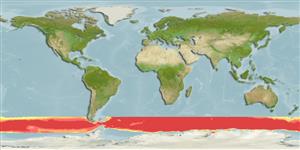Teleostei (teleosts) >
Gadiformes (Cods) >
Melanonidae (Melanonids)
Etymology: Melanonus: Greek, melan, -anos = black Greek, onos = hake.
More on author: Günther.
Environment: milieu / climate zone / depth range / distribution range
Ecology
Marine; bathypelagic; oceanodromous (Ref. 51243); depth range 150 - 3613 m (Ref. 11892), usually 600 - 1100 m (Ref. 9563). Deep-water; 50°S - 69°S
Circumpolar in subantarctic and temperate waters, occasionally being taken in the tropics (Ref. 6525). South Atlantic south of the Subtropical Convergence. Also captured recently in Prydz Bay, Antarctica.
Size / Weight / Age
Maturity: Lm ? range ? - ? cm
Max length : 18.7 cm SL male/unsexed; (Ref. 5209)
Oceanic species. Also mesopelagic (Ref. 7300). Has been recorded from over the continental slope in depths of 600 to 1,100 m (Ref. 9563). Biology unknown (Ref. 7130).
Life cycle and mating behavior
Maturity | Reproduction | Spawning | Eggs | Fecundity | Larvae
Chiu, T.S. and D.F. Markle, 1990. Melanonidae. p. 188-189. In O. Gon and P.C. Heemstra (eds.) Fishes of the Southern Ocean. J.L.B. Smith Institute of Ichthyology, Grahamstown, South Africa. (Ref. 5209)
IUCN Red List Status (Ref. 130435)
Threat to humans
Harmless
Human uses
Fisheries: of no interest
More information
ReferencesAquacultureAquaculture profileStrainsGeneticsElectrophoresesHeritabilityDiseasesProcessingNutrientsMass conversion
Tools
Special reports
Download XML
Internet sources
Estimates based on models
Preferred temperature (Ref.
123201): -1.4 - 2.6, mean 1.4 °C (based on 81 cells).
Phylogenetic diversity index (Ref.
82804): PD
50 = 1.0000 [Uniqueness, from 0.5 = low to 2.0 = high].
Bayesian length-weight: a=0.00372 (0.00143 - 0.00963), b=3.10 (2.88 - 3.32), in cm total length, based on LWR estimates for this (Sub)family-body shape (Ref.
93245).
Trophic level (Ref.
69278): 3.5 ±0.3 se; based on size and trophs of closest relatives
Fishing Vulnerability (Ref.
59153): Low vulnerability (13 of 100).
